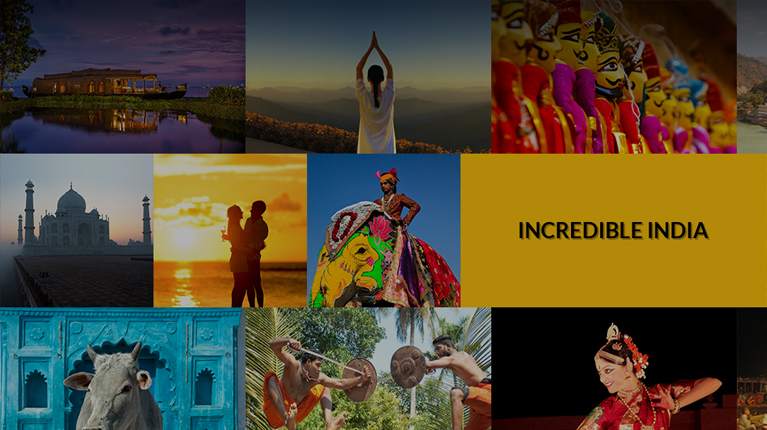

Duration: 15 nights - 16 days
Locations: Delhi – Mandawa – Bikaner – Khimsar- Jaisalmer – Kumbalgarh – Udaipur –Samode- Bharatpur - Agra – Delhi
| Tour Highlights | |
| Delhi | Red Fort, Raj Ghat, Jama Masjid, Chandni Chowk, India Gate, President House, Humayun Tomb & Qutub Minar Optional Sound & Light Show at Red Fort with dinner at Chor Bizarre |
| Mandawa | Havelis (Mansion) of Goenka, Gori Shankar & Choudaharia with Frescoes |
| Bikaner | Junagarh Fort & Lal Garh Palace |
| Jaisalmer | Jaisalmer Fort , Jain Temple, Patwon Ki Haveli & Camel Safari |
| Jodhpur | Mehrangarh Fort & Jaswant Thada |
| Ranakpur | Jain Temple Complex |
| Udaipur | City Palace, Sahelion Ki Bari, Lok Kala Museum & Boat Ride at Lake Pichola Optional Sound & Light Show / Vintage Car collection |
| Jaipur | Elephant ride to Amber Fort Palace , City Palace, Jantar Mantar (Observatory) & Hawa Mahal (Palace of Winds) Optional Cultural evening at Chokhi Dhani, |
| Bharatpur | Bird Sanctuary |
| Fatehpur Sikri | Akbars Residential Palace, Mosque & Tomb of Salim Chisti |
| Agra | Taj Mahal, Agra Fort, Sikandara |
| Mathura & Vrindavan | Shri Krishna Janmabhumi Temple, Bankey Bihari Temple & ISKCON Temple |
Detailed Itinerary
Day 01: Arrive Delhi
Arrive by International flight, after traditional 'Swagat' (Welcome) our representative would assist you at airport & transfer to hotel for check in.
Delhiisa bustling metropolis, which successfully combines in its folds the ancient with modern. Its strategic location was the prime reasons why successive dynasties chose it as their seat of power. In fact, more mythological cities are believed to be here, like the city of Indraprastha from the Hindu epic Mahabharata, founded around 5000 BC. Numerous monuments were built over several centuries by different rulers like Qutub-ud-din Aibek, Alauddin Khilji, Tughlaks, Humayun & Shah Jahan, who built the Walled City Shah Jahanabad.
Later in first half of 20th century much of New Delhi was planned by Sir Edwin Lutyens, who laid out a grandiose central administrative area as a testament to British rule in India. The division in walled city & New Delhi also marks the division in life styles.
Overnight Hotel – Delhi (B)
Day 02: Delhi - Mandawa (260 km - 6 hr)
Today, we drive to we drive to Mandawa in the heart of the semi-arid Shekhawati region. Shekhawati owes its name to Rao Shekha who ruled this area in the 14th century. The Fort of 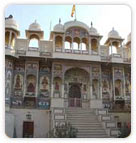 Mandawa was built in the year 1755 by Thakur Nawal Singh, the founder of the town. These were the times when Mandawa was settled & fortified by the rich & dominant Silk Route merchants of the region, who constructed many Havelis (Mansions), Chhatris (Cenotaphs), Temples & Baolis (Step-wells) with ornate frescoes adorning their walls & now aptly given the epithet– Open-Air Gallery. With the migration of these merchant families, their old settlements remained in total obscurity with no one to look after them. Mandawa still retains the charm & aura of a bygone era & coming here is like stepping into a different world.
Mandawa was built in the year 1755 by Thakur Nawal Singh, the founder of the town. These were the times when Mandawa was settled & fortified by the rich & dominant Silk Route merchants of the region, who constructed many Havelis (Mansions), Chhatris (Cenotaphs), Temples & Baolis (Step-wells) with ornate frescoes adorning their walls & now aptly given the epithet– Open-Air Gallery. With the migration of these merchant families, their old settlements remained in total obscurity with no one to look after them. Mandawa still retains the charm & aura of a bygone era & coming here is like stepping into a different world.
Overnight Heritage Hotel – Mandawa (B)
Day 03: Mandawa - Bikaner (160 km - 4 hr)
Half Day Tour
Today we take a tour covering the Shekhawati region known for exquisite frescoes decorating the walls & ceilings of the havelis. We visit State of the Art Havelis namely Goenka haveli, built in the year 1885 is believed to have some of the best frescos in perfect match of colour & design. Gori Shankar Haveli, a good example of mirrored mosaic ceiling. Choudaharia Haveli, though in an extreme state of deteriorations has a rare departure of an erotic painting. The Singhania Haveli has some fine paintings of Radha & Krishna & shows some British men holding guns.
Later we drive to Bikaner, was founded by Rao Bikaji in the year 1488. He was a Rajput prince, descendent of the founder of Jodhpur (1459 AD) & chose a barren land called Jungladesh to shape it into an impressive city, called Bikaner.
Overnight Hotel – Bikaner (B)
Day 04: Bikaner – Khimsar (150km – 3 hr)
Half Day Tour
Today in Bikaner we visit Junagarh Fort, built by Raja Rai Singhji, the 6th ruler of Bikaner, who ruled during 1571-1612. It is constructed of red sandstone & marble with kiosks & balconies embellishing the structure at intervals. Later we visit Lal Garh Palace, an architectural masterpiece in red sandstone, built by Maharaja Ganga Singh (1881-1942) in memory of his father Maharaja Lal Singh. It is a magnificent example of pure Rajput martial architecture, designed by Sir Swinton Jacob of England.
Later we drive to Khimsar, perched on the edge of the great Thar Desert. Unique fort at Khimsar offers a wide range of experiences. The Battle-scarred walls & turrets remind one of the glorious past. The initial construction began in 1523 AD, the family moved in during the 18th Century when a new 'Zenana' (ladies wing) was constructed. Thakur Onkar Singh built a regal wing for himself in 1940s. Today, the Khimsar Fort ranks high amongst the premier classified heritage hotels of India.
En route we visit the world famous Rat Temple at Deshnok. Later we visit the 15th century fortress where the Maharaja Ajay Singh of Naga Dynasty.
Overnight Hotel – Khimsar (B).
Day 05: Khimsar - Jaisalmer (240 km - 6hr)
Later we drive to Jaisalmer, founded in the year 1156 by Bhatti Rajput ruler Rawal Jaisal. An important ancient trading centre because of its strategic location on the camel trade routes is often described as Golden city. Havelis, built by merchants of the 19th century, are exquisitely carved from golden-yellow sandstone & are still in a beautiful condition.
Overnight Hotel – Jaisalmer (B)
Day 06: Jaisalmer
Full Day Tour
 Today we visit the old town of Jaisalmer & visit Jaisalmer Fort, built in the year 1156 by Rawal Jaisal. Perched on 80m high hill, housing the entire township within its ramparts, the golden hued Fort is standing like a sentinel in the bleak desert landscape. It is the only “Living Fort” in India & within its ramparts has an enchanting cow-web of narrow lanes dotted with some lovely Havelis (Mansions),Palaces & beautifully sculptured JainTemples of the 12th-15th century AD & of course skilled artisans & ubiquitous camels.
Today we visit the old town of Jaisalmer & visit Jaisalmer Fort, built in the year 1156 by Rawal Jaisal. Perched on 80m high hill, housing the entire township within its ramparts, the golden hued Fort is standing like a sentinel in the bleak desert landscape. It is the only “Living Fort” in India & within its ramparts has an enchanting cow-web of narrow lanes dotted with some lovely Havelis (Mansions),Palaces & beautifully sculptured JainTemples of the 12th-15th century AD & of course skilled artisans & ubiquitous camels.
We also visit magnificent Patwon Ki Haveli in the heart of the town. It was built by the rich merchant Guman Chand Patwa & his sons, whose business stretched between Afghanistan & China. It is the most elaborate & magnificent of all the Jaisalmer Havelis & is virtually the showpiece of Jaisalmer's legendary architectural wealth. The carving on stone far surpasses in beauty the work on brocade & gold. Later we drive down 40 km away from Jaisalmer to Sam to take the Camel ride on the Sand Dunes of Sam while the sun is setting down.
Overnight Hotel – Jaisalmer (B)
Day 08: Jaisalmer – Osiyan (240 km - 6hr)
Today we drive to Osiyan, Situated midway between Jaisalmer & Jodhpur, the place is most famous for its Jain temples. 58 km away from Jodhpur the ancient township was located on a very important trade route between the 8-12th centuries. The town was dominated by the Jains, both commercially & demographically. Here the Jain built their temples of stunning quality. Along with Jain temples there are also superb Hindu temples dedicated to various Hindu gods. In all there are 16 Hindu & Jain temples of exquisite quality. Sad to say that Osiyans glory is a thing of the past, now the place resembles a ghost town with most of the people having migrated to greener pastures.
Half Day Tour
Jain Temples, the most spectacular of which is the Mahavira temple dedicated to the 24th & last Jain Prophets. The temple was built around 775 AD & other smaller shrines were added on to the complex till about the 15th century. Osiyan has great relevance for the Jain community because the Jains originated in Osiyan & derive their name from the town. Sachiya Mata Temple, originally built in the 8th century, the existing temple complex however dates back to the 12th century. Sachi Mata is better known as Indrani. The temple complex can be entered through a series of magnificent toranas or arches, which are superbly sculpted. The main shrine was constructed circa in the year 1178 & the two other temples in the complex, namely the Chandi Ka Mandir & the Amba Mata Mandir.
All in all the Sachiya Mata Temple complex & the other temples in Osiyan are probably some of the most beautiful temple complexes in the north India.
Overnight Hotel – Osiyan (B)
Day 09: Osiyan - Excursion to Jodhpur (60Km- 01hr Oneway)
Today we take a guided tour of Jodhpur, bustling desert city is the 2nd largest city in Rajasthan & has landscape dominated by the massive Mehrangarh Fort topping a sheer rocky ridge  Rao Jodha, a chief of the Rathore clan, founded the city in the year 1459 & it is named after him. It was formerly the seat of a Princely state, also known as Marwar.
Rao Jodha, a chief of the Rathore clan, founded the city in the year 1459 & it is named after him. It was formerly the seat of a Princely state, also known as Marwar.
Here we visit the Mehrangarh Fort (majestic fort), built by Rao Jodha, located atop a 125m high hill. The fort museum houses an exquisite collection of palanquins, howdah (Elephant saddle), royal cradles, miniatures, costumes & furniture. We also visit the Jaswant Thada, a white marble memorial built in the year 1899 in memory of Maharaja Jaswant Singh II. It is an architectural landmark in Jodhpur.
Overnight Hotel – Osiyan (B)
Day 10: Osiyan – Kumbalgarh (255km - 7hr)
Today we drive Kumbalgarh, Rana Kumbha the legendary Mewar hero, an astute & a great builder. Of others, Kumbalgarh is the most inspiring. A joy for the nature lovers, it is surrounded by greenery & wildlife. It is also within a short driving distance from the famous 15th century Ranakpur Jain Temples. An area steeped in history & abounding in wildlife, unspoilt nature harmonizes with the modern comforts & the warm hospitality of the Aoudhi.
En route Ranakpur
Ranakpur, located in the mountain ranges of Pali. We visit the famous Ranakpur Jain Temples were built during the reign of the liberal & gifted monarch Rana Kumbha in the 15th century. An enormous basement covers 48,000 sq. feet area. There are four subsidiary shrines, 24 pillared halls & eligibly domes supported by over four hundred columns. The artistically carved nymphs playing the flute in various dance postures at a height of 45 feet are an engrossing sight. In the assembly hall, there are two big bells weighing 108 kg whose sound echoes in the entire complex.
Overnight Hotel – Kumbalgarh (B)
Day 11: Kumbalgarh - Udaipur (100Km- 02hr)
Today we take drive to Udaipur, was founded in the year 1568 by Maharana Udai Singh after his final unsuccessful attempt to defend the Mewar capital, Chittorgarh from the invading Mughals under Emperor Akbar. The Kingdom of Mewar was considered the most respectable among all Princely states in Rajasthan & still remembered for the courage to protect the Kingdom. The site for Udaipur was chosen for its natural beauty, abundant water & natural protection afforded by the surrounding forests & Aravali mountains. It is set on the edge of three lakes & also known as the "City of Lakes & Palaces". Undoubtedly one of the most romantic cities in India, its beautiful Palaces are mirrored in the calm waters of Lake Pichola & the city is a brilliant kaleidoscope of narrow lanes flanked by bright stalls, gardens, lakes, palaces & temples.
Overnight Hotel – Udaipur (B)
Day 12: Udaipur
Full day Tour
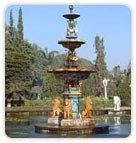 Toady we visit the City Palace, an intriguing collection of buildings contributed by various Maharanas (Kings) after Udai Singh & built in the year 1725. The magnificence of the Palace starts right from its entrance at the northern Tripolia Gate that brings us to the central courtyard, the best place to view the facade of filigreed balconies & ornate cupola-topped towers. Sahelion ki Bari (Garden of Maids of Honour) is an ornamental garden built by Maharana Sangram Singh for his daughter & the Ladies of the Queen's court. He built the garden with several fountains, pools & is decorated with chiselled pavilions & elephants. The fountains worked on the unique hydraulic technique devised in the year 1700 AD & work till today.
Toady we visit the City Palace, an intriguing collection of buildings contributed by various Maharanas (Kings) after Udai Singh & built in the year 1725. The magnificence of the Palace starts right from its entrance at the northern Tripolia Gate that brings us to the central courtyard, the best place to view the facade of filigreed balconies & ornate cupola-topped towers. Sahelion ki Bari (Garden of Maids of Honour) is an ornamental garden built by Maharana Sangram Singh for his daughter & the Ladies of the Queen's court. He built the garden with several fountains, pools & is decorated with chiselled pavilions & elephants. The fountains worked on the unique hydraulic technique devised in the year 1700 AD & work till today.
Later we visit Jagdish Temple, the Indo-Aryan temple, built in the year 1651 AD by Maharana Jagat Singh, is the largest & the most beautiful temple of Udaipur with noteworthy sculpted images. We also enjoy boat ride on Lake Pichola, the beauty of the lake is enhanced by the surrounding hills, palaces, temples, bathing ghats & embankments. The Jag Niwas (Lake Palace) & Jag Mandir, the two island palaces on the lake look like pearls in the lake.
Overnight Hotel – Udaipur (B)
Day 13: Udaipur – Jaipur (Flight 9W-373-0740hr-0825hr)
Today You will transfer to airport to board flight for Jaipur, popularly known as Pink City the flamboyant & colourful capital of Rajasthan. With its rich & colourful past, resplendent with tales of valour & bravery, it is now one of the most important heritage cities in India. The city was founded in 1728 by Maharaja Sawai Jai Singh II, the ruler of Amber. It remains the only city in the world symbolizing the nine divisions of the universe, through nine rectangular sectors.
Full Day Tour
Today we take an excursion to Amber Fort, the palace complex which stands to this date was commenced under the reign of Raja Man Singh. We take an Elephant ride to reach the Fort situated on the hill, an overwhelming experience.
Later we visit the City Palace, a perfect blend of Rajasthani & Mughal architecture. The center of the palace is a seven-storied building called Chandra Palace, with fine views over the gardens & the city. Further we visit Jantar Mantar (Solar Observatory), an astronomical treasure house, with solar devices that give accurate predictions till date. We also visit Hawa Mahal (Palace of Winds), a five-storied structure of pink sandstone. It was built in the year 1799 so that veiled royal women could peer down the busy street market unseen by the world through its 593 stone Jharokas (mini windows).
Overnight Hotel – Samode (B)
Day 14: Samode – Bharatpur (195 km – 5 hr)
Today we drive to Bharatpur, founded by Maharaja Suraj Mal in the year 1733. It was once an impregnable, well-fortified city, & the capital of a kingdom ruled by Jat 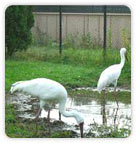 maharajas. The trio of Bharatpur, Deeg & Dholpur has played an important part in the Jat history of Rajasthan.
maharajas. The trio of Bharatpur, Deeg & Dholpur has played an important part in the Jat history of Rajasthan.
Sanctuary was previously known as Bharatpur bird Sanctuary & now known as Keoladeo National Park. The name Keoladeo is derived from the name of an ancient Hindu temple devoted to Lord Shiva in the sanctuary's central zone while the Hindi term 'Ghana' implies dense, thick areas of forest cover. This is a magnificent park having one of the World’s greatest & most important heronries. It is situated at the confluence of Ghambhir & Banganga Rivers in Bharatpur district. Now a World Heritage site by UNESCO, this former duck-hunting reserve of the Maharajas is one of the major wintering areas for large numbers of aquatic birds from Afghanistan, Siberia & Turkmenistan. Some 364 species of birds, including the rare Siberian Crane, have been recorded in the park.
Overnight Hotel – Bharatpur (B)
Day 15: Bharatpur – Agra via Fatehpur Sikri (55 km – 2 hr)
Today we drive to Agra, en route we will visit Fatehpur Sikri (Ghost Capital), the political capital of India's Mughal Empire under Akbar's reign, from the year 1571 until 1585, when it was abandoned, ostensibly due to lack of water. We visit Emperor Akbar's Residential complex,Mosque & Tomb of Salim Chisti.
Further we continue our drive to Agra, beautifully situated on the banks of river Yamuna. It achieved prominence as the capital of the Mughal Emperors from the year 1526 to 1628, remains major tourist destination because of its many splendid Mughal-era monuments, most notably the Taj Mahal, Agra Fort & Fatehpur Sikri, all three are UNESCO World Heritage sites.
Overnight Hotel – Agra (B)
Day 16: Agra – Delhi via Mathura & Vrindavan (220km - 5hr)
Half Day Tour
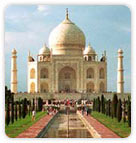 Today we visit Taj Mahal, symbol of eternal love, which stands on the banks of River Yamuna. It was built by the 5th Mughal Emperor, Shah Jahan in the year 1631 in memory of his wife, Mumtaz Mahal. It was completed in 22 years. Further we visit Agra Fort, taken over from the Lodhis by the Mughal Emperor Akbar in the late 16th century. The Fort can be more accurately described as a walled palatial city. It was built from red sandstone, often inlaid with white marble & intricate decorations. We will also visit Sikandara, Akbar's tomb. His son Jahangir completed the construction of the tomb in the year 1613.
Today we visit Taj Mahal, symbol of eternal love, which stands on the banks of River Yamuna. It was built by the 5th Mughal Emperor, Shah Jahan in the year 1631 in memory of his wife, Mumtaz Mahal. It was completed in 22 years. Further we visit Agra Fort, taken over from the Lodhis by the Mughal Emperor Akbar in the late 16th century. The Fort can be more accurately described as a walled palatial city. It was built from red sandstone, often inlaid with white marble & intricate decorations. We will also visit Sikandara, Akbar's tomb. His son Jahangir completed the construction of the tomb in the year 1613.
Later we drive back to Delhi, en route visit Mathura & Vrindavan, places related with the birth & childhood of Lord Krishna. In Mathura we visit Shri Krishna Janmabhumi temple, a stone slab marks the original birth place of Krishna. In Vrindavan we visit Bankey Bihari Temple, built in the year 1864. Temple is famous for the black statue of Krishna, also called as Thakur Ji. ISKCON Temple, one of the most beautiful temples in Vrindavan. Temple is devoted to Krishna, his brother Balaram & Krishna's beloved Radha.
Further we continue our drive to Delhi, upon arrival in Delhi Transfer to Airport for onward Destination.
Our tour concludes: We thank you for your patronage & look forward to serve you again in near future.
Package includes:
Package does not include: